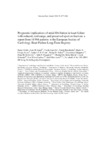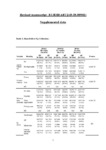Mostrar o rexistro simple do ítem
Prognostic implications of atrial fibrillation in heart failure with reduced, mid-range, and preserved ejection fraction: a report from 14 964 patients in the European Society of Cardiology Heart Failure Long-Term Registry
| dc.contributor.author | Zafrir, Barak | |
| dc.contributor.author | Lund, Lars H. | |
| dc.contributor.author | Laroche, Cecile | |
| dc.contributor.author | Ruschitzka, Frank | |
| dc.contributor.author | Crespo-Leiro, María Generosa | |
| dc.contributor.author | Coats, Andrew J.S. | |
| dc.contributor.author | Anker, Stefan | |
| dc.contributor.author | Filippatos, Gerasimos | |
| dc.contributor.author | Seferovic, Petar M. | |
| dc.contributor.author | Maggioni, Aldo P. | |
| dc.contributor.author | Mora Martín, Manuel De | |
| dc.contributor.author | Polonski, Lech | |
| dc.contributor.author | Silva-Cardoso, José | |
| dc.contributor.author | Amir, Offer | |
| dc.date.accessioned | 2019-01-10T08:49:31Z | |
| dc.date.issued | 2018-10-15 | |
| dc.identifier.citation | Zafrir B, Lund LH, Laroche C, et al. Prognostic implications of atrial fibrillation in heart failure with reduced, mid-range, and preserved ejection fraction: a report from 14 964 patients in the European Society of Cardiology Heart Failure Long-Term Registry. Eur Heart J. 2018; 38(48): 4277-4284 | es_ES |
| dc.identifier.issn | 0195-668X | |
| dc.identifier.uri | http://hdl.handle.net/2183/21561 | |
| dc.description.abstract | [Abstract] Aim. To investigate the characteristics long-term prognostic implications (up to ∼2.2 years) of atrial fibrillation (AF) compared to sinus rhythm (SR), between acute and chronic heart failure (HF) with reduced (HFrEF < 40%), mid-range (HFmrEF 40–49%), and preserved (HFpEF ≥ 50%) ejection fraction (EF). Methods and results. Data from the observational, prospective, HF long-term registry of the European Society of Cardiology were analysed. A total of 14 964 HF patients (age 66 ± 13 years, 67% male; 53% HFrEF, 21% HFmrEF, 26% HFpEF) were enrolled. The prevalence of AF was 27% in HFrEF, 29% in HFmrEF, and 39% in HFpEF. Atrial fibrillation was associated with older age, lower functional capacity, and heightened physical signs of HF. Crude rates of mortality and HF hospitalization were higher in patients with AF compared to SR, in each EF subtype. After multivariable adjustment, the hazard ratio of AF for HF hospitalizations was: 1.036 (95% CI 0.888–1.208, P = 0.652) in HFrEF, 1.430 (95% CI 1.087–1.882, P = 0.011) in HFmrEF, and 1.487 (95% CI 1.195–1.851, P < 0.001) in HFpEF; and for combined all-cause death or HF hospitalizations: 0.957 (95% CI 0.843–1.087, P = 0.502), 1.302 (95% CI 1.055–1.608, P = 0.014), and 1.365 (95% CI 1.152–1.619, P < 0.001), respectively. In patients with HFrEF, AF was not associated with worse outcomes in those presenting with either an acute or a chronic presentation of HF. Conclusions. The prevalence of AF increases with increasing EF but its association with worse cardiovascular outcomes, remained significant in patients with HFpEF and HFmrEF, but not in those with HFrEF. | es_ES |
| dc.language.iso | eng | es_ES |
| dc.publisher | Oxford | es_ES |
| dc.relation.uri | https://doi.org/10.1093/eurheartj/ehy626 | es_ES |
| dc.rights | This article contains public sector information licensed under the Open Government Licence v3.0 (http://www.nationalarchives.gov.uk/doc/open-government-licence/version/3/) | es_ES |
| dc.subject | Heart failure | es_ES |
| dc.subject | Atrial fibrillation | es_ES |
| dc.subject | Hospitalizations | es_ES |
| dc.subject | Mortality | es_ES |
| dc.subject | Ejection fraction | es_ES |
| dc.subject | Prognosis | es_ES |
| dc.title | Prognostic implications of atrial fibrillation in heart failure with reduced, mid-range, and preserved ejection fraction: a report from 14 964 patients in the European Society of Cardiology Heart Failure Long-Term Registry | es_ES |
| dc.type | info:eu-repo/semantics/article | es_ES |
| dc.rights.access | info:eu-repo/semantics/embargoedAccess | es_ES |
| dc.date.embargoEndDate | 2019-10-15 | es_ES |
| dc.date.embargoLift | 2019-10-15 | |
| UDC.journalTitle | European Heart Journal | es_ES |
| UDC.volume | 39 | es_ES |
| UDC.issue | 48 | es_ES |
| UDC.startPage | 4277 | es_ES |
| UDC.endPage | 4284 | es_ES |
| UDC.coleccion | Investigación | es_ES |
| UDC.departamento | Ciencias da Saúde | es_ES |
| UDC.grupoInv | Grupo de Investigación Cardiovascular (GRINCAR) | es_ES |
| UDC.grupoInv | Insuficiencia Cardíaca Avanzada e Transplante Cardíaco (INIBIC) | es_ES |
| UDC.institutoCentro | INIBIC - Instituto de Investigacións Biomédicas de A Coruña | es_ES |
Ficheiros no ítem
Este ítem aparece na(s) seguinte(s) colección(s)
-
Investigación (FEP) [498]







